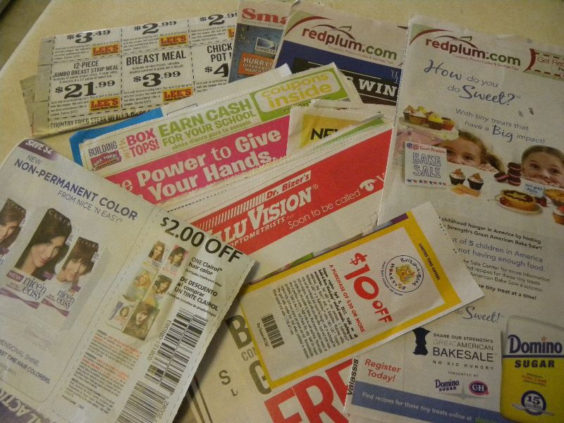
Many coupon users believe that extreme couponers ruined everything. Their over-the-top exploits, celebrated on TV, caused retailers and manufacturers to crack down. Coupon policies got stricter, coupon redemption requirements got more complicated and coupon values went down. But if things don’t get better soon, it may not be extreme couponers’ fault anymore. You can blame casual couponers, who just want couponing to be more convenient – even if the coupons themselves aren’t that great.
The coupon processing company Inmar has released its “2013 Coupon Trends” report, which compiles and analyzes coupon facts and figures from 2012. Unlike other similar studies, this one incorporates results from a survey of coupon users. So not only do we find out the number and types of coupons offered last year, we learn what couponers think about it – and what couponers want in the future.
Many of the numbers from Inmar’s report tell the same story that an NCH Marketing report told in January (read: “Couponers to Companies: Is That All You’ve Got?”). Both find that coupons have lower values, shorter expiration dates, more purchase requirements, there are fewer coupons for food products – and, consequently, coupon redemption is down.
One faction is using those numbers to argue that it’s time to go big on digital (read: “Safeway Chief Predicts End of Paper Coupons”). If coupon use is down, they say, that must mean people are looking for other, better ways to save. Another faction believes it’s no surprise that less appealing coupons are redeemed less often. Coupon issuers simply engineered a lower redemption rate, in order to help bring a sky-high rate of coupon usage back down to earth (read: “Paper Coupons: Reports of Our Death Have Been Greatly Exaggerated”).
What does Inmar’s survey of coupon users find? Both arguments, to some extent, are true. It just depends on what type of couponer you ask.
60% of coupon users surveyed are committed to coupons – they told Inmar they use coupons “all the time” or “usually.” The other 40% are more casual couponers – they use coupons “about half the time” or “rarely.” Non-coupon users were not included in the survey.
So what’s keeping those casual couponers from stepping up their game? Couponing is just too hard, they say. 53% of coupon users said they can’t find coupons for the products they want to buy. 32% report being confused about the purchase requirements on some coupons. And 1 in 5 find their store’s coupon policy confusing. “There seem to be so many rules to use coupons,” one shopper complained. “I don’t want to have to carry around the store coupon policies in order to get a deal.”
Call it the “Extreme Couponing” effect. At the peak of the TV show’s popularity, many stores began clarifying and tightening their coupon policies, and many manufacturers started adding new restrictive fine print on their coupons. Combine that with the less attractive coupon offers overall, and many shoppers simply threw up their hands in frustration.
We just want couponing to be easy, many shoppers told Inmar – and the statistics show it. Of all the different types of coupons available in 2012, peelies had the highest rate of redemption by far, closely followed by tearpads and blinkies. In other words, coupons that we don’t have to work for – that we just find in the store – are most likely to be used. Digital coupons are further down the list, but rising, while newspaper insert coupons are near the bottom. Insert coupons still make up nearly 89% of all coupons distributed, but they represent less than half of all coupons redeemed.
Maybe all that cutting, sorting and organizing is just too much work. 78% of those surveyed said they’d like if coupons were automatically applied to their purchase. And 37% agreed with the statement, “I wish all coupons were digital.” “I love that my store now automatically puts coupons on my store loyalty card,” one shopper said. “It gives me the savings without the headache.”
“Shoppers are learning how to adopt emerging technology to help them make their dollars go farther,” Inmar concludes. “We believe there is emerging, pent-up demand for digitally powered shopping in the physical store.” If we see a similar drop in coupon redemption in 2013, Inmar says, that would “strengthen the hypothesis that a fundamental, seismic shift regarding coupon use away from paper methods and toward digital… is indeed underway.”
The true “seismic shift” could actually be a move away from what serious couponers want, to what casual couponers want. Serious couponers don’t mind putting in the time and effort to gather paper and internet printable coupons, as long as those coupons are worth their time. Casual couponers want their stores to do the work for them, by making more paper coupons available in store, and automatically loading digital ones to their loyalty cards.
And casual couponers are the ones that retailers and manufacturers have their eyes on. Businesses aren’t too interested in an extreme couponer who gathers 20 coupons, buys 20 products for next to nothing, and doesn’t buy the product again for a very long time. They’d rather see 20 individuals use one coupon each to buy one product, and perhaps some will become regular customers who might even pay full price next time. Making coupons easier to use, whether by handing them out in store, or offering them digitally, is to those shoppers’ – and businesses’ – benefit.
If you’re in the “serious couponer” camp, and have ever complained that those who issue coupons aren’t listening to couponers, you’re half right. They are listening to couponers. They’re just not listening to you.











I think the people selling off hoards are ruining coupons. I get the Sunday paper and the coupons get lamer & lamer. Cereal coupons are nonexistant and so many have short exp dates on them. Occasionally I might stock up on something and buy 3-4 of the same item, but I just don’t get how these people get so cheap that it makes sense to clear the shelf, and then sell them. Lets say there is a bottle of shampoo for $4. Lets say there is a coupon for $3 off 2, and somehow it gets doubled. Thats still $1 each. Then they sell them at a garage sale for $2 each. I could have bought them at the store for about the same price and not have to wonder how they were stored, plus I don’t see how after all the effort that making the $1/bottle was even worth their time.
And where are they getting so many coupons? If buying them through a “service”, that cuts into the profit. If the have a buddy in the delivery service, they’re getting them illegally.
Also, reselling is illegal for most of what they sell. Heath and beauty aids have to be stored properly according to the law. The garage doesn’t have climate control or rodent protection.
On loyalty cards they don’t double. Whereas paper does up to $1.00. I love the .75 coupons because its a $1.50 off and if its on sale the better. Times are hard and I use coupons as much as possible.
Newspaper subscriptions are down across the country. That would likely account for fewer print coupon books actually being used. When I worked at our local paper, pallets of coupons went unused each week, despite being ordered and paid for, because the subscription rates dropped dramatically. Online content is at least partially responsible for the drop, and while online coupons can be great, the cost of paper and ink often outweighs the potential savings.
I’m a casual couponer and I rely on internet printable coupons. And occassionally, I am able to stack store and printable manufacturer coupons to get something for almost nothing, which makes me happy as a shopper, of course…and businesses need to know that because of that, I am more likely to go back to that store to buy and spend money on items that I don’t even have a coupon for because I love that the store allows me such great deals with my printable coupons once in a while. Couponing is NOT hard! Perhaps, “Thinking” for them is hard. I can understand that it would be hard for extreme couponers…clipping and sorting. For a casual couponer like me…it’s EASY. In my opinion, It’s a part of conditioning……..to promote digital coupon cards and discourage paper coupon usage. As a shopper, I like that I have control over my coupon savings and I don’t like the idea of purchases being tracked. I wonder if that survey is even real.
And another thing…I’m all for limiting the number of like coupons to four per day, that’s fair. I support limiting the number to, perhaps, ten of the same items per day. You know, this is one of the best things I love about being an American, my freedom to save. To dictate and limit a shopper to only use one coupon for one item per day, I think that’s communism.
Communism? It’s their business. You’re trying to get their manufactured product for free. They bought the raw resource, packaged it, shipped it and paid several people do the processes.
How is that communism? Sounds like you want communism,
Very interesting and it makes a lot of sense. I don’t like it however! lol
We live with/have created a generation that wants and expects ‘something for nothing.’ They want ‘automatic’ savings. Just like paychecks without work. Same thing.
Coupons ‘magically’ appearing on your shoppers card? With stacking being prohibited…that is another argument!